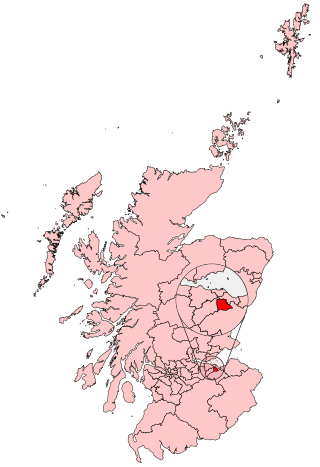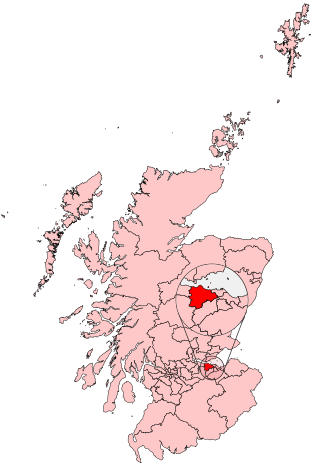
John David Home Robertson is a retired Labour politician in Scotland. He was a Member of Parliament (MP) for Berwick and East Lothian and East Lothian from 1978 to 2001 and a Member of the Scottish Parliament (MSP) for East Lothian from 1999 until 2007.

Edinburgh South is a constituency of the House of Commons of the UK Parliament created in 1885. The constituency has been held by Scottish Labour since 1987. The seat has been represented since 2010 by Ian Murray, who currently serves as Secretary of State for Scotland under the government of Keir Starmer. Murray was the only Labour MP in Scotland to retain his seat at the 2015 and 2019 general elections and this is one of only three seats and the only Labour-held seat of the so-called "tartan wall" never held by the Scottish National Party (SNP).

Edinburgh West is a burgh constituency of the House of Commons of the Parliament of the United Kingdom, first contested at the 1885 general election.
Berwick and Haddington was a constituency of the House of Commons of the Parliament of the United Kingdom from 1918, when it replaced the separate Berwickshire and Haddingtonshire constituencies, until it was renamed Berwick and East Lothian for the 1950 general election. It elected one Member of Parliament (MP), using the first-past-the-post voting system.

Aberdeen South is a burgh constituency of the House of Commons of the Parliament of the United Kingdom which elects one Member of Parliament (MP) by the first-past-the-post system of election.

East Renfrewshire is a constituency of the UK House of Commons, to the south of Glasgow, Scotland. It elects one Member of Parliament (MP) using the first-past-the-post system of voting.

East Lothian is a constituency of the Scottish Parliament (Holyrood) covering most of the council area of East Lothian. It elects one Member of the Scottish Parliament (MSP) by the plurality method of election. It is also one of nine constituencies in the South Scotland electoral region, which elects seven additional members, in addition to the nine constituency MSPs, to produce a form of proportional representation for the region as a whole.

Edinburgh Central was a burgh constituency of the House of Commons of the Parliament of the United Kingdom from 1885 to 2005. It elected one Member of Parliament (MP) by the first past the post system of election.
Argyllshire was a county constituency of the House of Commons of the Parliament of Great Britain from 1708 to 1800 and of the House of Commons of the Parliament of the United Kingdom from 1801 until 1983. The constituency was named Argyll from 1950. The constituency was replaced in 1983 with Argyll and Bute.
Berwickshire was a county constituency of the House of Commons of the Parliament of the United Kingdom from 1708 to 1918, when it was amalgamated with neighbouring Haddington(shire) to form a new Berwick and Haddington constituency.

Dumfriesshire was a county constituency represented in the House of Commons of Great Britain from 1708 to 1801 and in the House of Commons of the Parliament of the United Kingdom from 1801 until 2005. It was known as Dumfries from 1950.
Lanark was a county constituency of the House of Commons of the Parliament of the United Kingdom (Westminster) from 1918 to 1983. It elected one Member of Parliament (MP) by the first past the post voting system.
Linlithgowshire was a Scottish county constituency of Great Britain and after 1801 the House of Commons of the Parliament of the United Kingdom from 1708 to 1950. It elected one Member of Parliament (MP) by the first past the post voting system. It was replaced in 1950 by an equivalent constituency named West Lothian.
Clackmannan and Eastern Stirlingshire was a parliamentary constituency in the Clackmannan area of Central Scotland. It returned one Member of Parliament (MP) to the House of Commons of the Parliament of the United Kingdom, elected by the first past the post system.
Angus North and Mearns was a county constituency represented in the House of Commons of the Parliament of the United Kingdom from 1950 to 1983. It elected one Member of Parliament (MP) by the first past the post voting system.

Roxburgh and Berwickshire was a county constituency of the House of Commons of the Parliament of the United Kingdom (Westminster) from 1983 to 2005. It elected one Member of Parliament (MP) by the first-past-the-post voting system.
Haddingtonshire was a Scottish county constituency represented in the House of Commons of Great Britain and the House of Commons of the United Kingdom from 1708 to 1918.

Tweeddale, Ettrick and Lauderdale was a county constituency represented in the House of Commons of the Parliament of the United Kingdom from 1983. In 2005 the constituency was abolished and the area is now represented by Berwickshire, Roxburgh and Selkirk, Midlothian, and Dumfriesshire, Clydesdale and Tweeddale.

Hendon North was a constituency in the former Municipal Borough of Hendon which returned one Member of Parliament (MP) to the House of Commons of the Parliament of the United Kingdom. It was created for the 1945 general election as the existing Hendon constituency was too large, and lasted until the 1997 general election when the London Borough of Barnet's Parliamentary representation was reduced from four seats to three.
The 1978 Berwick and East Lothian by-election was a by-election held for the House of Commons constituency of Berwick and East Lothian in Scotland on 26 October 1978. It was one of two UK parliamentary by-elections held on that day, and was won by the Labour Party candidate John Home Robertson.











